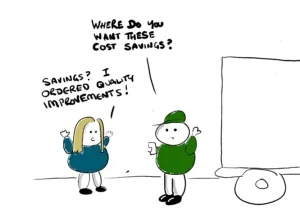Imagine being a shopper in a store, where every aisle is filled with items and multiple choices. As you stroll through the store looking at the items on the shelves, the ‘unwritten’ rule of purchase pops into your mind. If something doesn’t offer value, it is likely to stay on the shelf and not make its way into your trolley.
Now let’s extend this scenario beyond shopping and step into the shoes of an executive and a decision-maker in a business. Picture yourself, not just as a shopper but as a strategic buyer for the business. As you carefully assess items for their value, you also scrutinise potential investments, while ensuring that each item aligns with business goals and adds value.
Just as we carefully choose what adds value to our daily lives in a shop, businesses must critically assess and invest in assets, services, or strategies that bring tangible value to their operations and business objectives. Therefore, being able to prove value to others in the business is vital. But how do we go about that for Data Governance?
Difficulties proving worth
There is little doubt that sometimes data governance can feel intangible. Isn’t Data Governance going to slow us down? It’s nice to have but not a must-have, isn’t it? What is the value of trust in data? What value does increased ability to collaborate bring? Giving the right people access and the ability to understand the data brings what value exactly?
Data and Analytics leaders often find it challenging to create a compelling business case for data and analytics governance improvement. Often, the business case is too technical and complex, which makes business stakeholders switch off and file it for another day.
So how do you go about showing why this is essential without sending your audience to sleep?
Tracking the impact of a change made by Data Governance to an outcome can be hard. For example, if we increase customer data quality, what impact does that have on sales or customer retention?
So, it is hard proving the worth of Data Governance. Just like the classic duck-rabbit image, people might see different things based on their understanding and the position they take towards it. How do we get the right people to understand Data Governance and see the value it brings?
Also be aware, the benefits of data governance can take time to materialise. How long before that is useful enough to be utilised for long-term planning and decision-making? When can you claim a saving in fines for adhering to regulations when they have never been directly sanctioned?
All these things make it difficult to quantify value in Data Governance, but it is by no means impossible.
What is the value of Data Governance?

Data Governance initiatives rarely start because someone just decides to do it. Businesses typically embark on these initiatives in response to growing concerns related to data risks, compliance challenges, and operational inefficiencies.
As defensive strategies, Data Governance initiatives act as preventive measures, safeguarding against data breaches, compliance violations and reputational damages.
They also pre-emptively address vulnerabilities and risks, which shows a strategic and forward-thinking approach. This proactive stance is necessary in the face of evolving data landscapes and the increasing complexity of regulatory requirements.
However, it is not just about defence. Offensive strategies that rely on high quality data, well-defined, accessible data often require Data Governance assistance. Businesses can leverage a well-established Data Governance framework to proactively drive business initiatives and gain a competitive edge. Governance can help to create business value through monetisation and exchange of information products in addition to helping you to allocate your scarce resources to high priority projects in line with the organisations strategic goals.
Now, when it comes to measuring the value of Data Governance, businesses often face the challenge of quantifying the value of this initiative. To effectively measure this value, we must understand the business needs. Why is your business in need of Data Governance? Is it because a project relies on high-quality data to be successful? Are customers getting a poor experience because advisors in one business function can’t see updated data entered by another function? Is the business struggling to meet regulatory demands?
Once we understand the business needs, it is easier to evaluate the value of Data Governance on key business outcomes, such as customer satisfaction and regulatory compliance.
Identifying the value of Data Governance is also a crucial step to measuring the value of data governance initiatives. In doing this, defining precise metrics and key performance indicators (KPIs) can be used to measure the value. If there has been prior identification, great! We’ve got our starting point for what value we are expecting to realise.
If not, then we can work out what value we are expecting to deliver by quantifying how we are going to contribute to the overall value. How much are we expecting to increase our colleague’s productivity by making data accessible? If a colleague cost £X per day, what does that productivity increase equate to?
What is the likelihood and severity of risks currently and how much will we reduce that? If the expected cost of the risk was Y, what does the reduced likelihood and severity reduce that to? How much will we increase customer satisfaction through making customer data more accurate and secure? If that is expected to increase total customer lifetime value or customer retention rates, what is the value of the data?
By regularly monitoring these metrics and analysing the results, we can effectively gauge the tangible benefits derived from Data Governance.
Let`s consider this scenario: A retail business is suffering from delayed customer shipment and invoicing due to inaccurate, incomplete and duplicate customer data on their system. They need to get better at managing this or they will lose business.
By adopting a Data Governance approach focused on Data Quality, the business was able to fix its customer data, significantly improving the Order-to-Delivery time and increase customer satisfaction, retention and loyalty.

The closer you can get to value that is measurable, the better. If you are struggling with that, here is a top tip: Make friends with a Management Accountant. Aside from the fact that they make great friends, they are also great at taking business decisions and working out what they mean in pounds and pence (or whatever denomination you work in).
Great, we have some value we can attribute to Data Governance effort, job done. Or maybe not. If other people are not aware of the value you are delivering then when those senior leadership discussions happen, how are they going to take it into account?
The final and most important bit – Communicate the value! For the value of data governance to be meaningful, it needs to be communicated effectively through compelling storytelling to engage the hearts and minds of your stakeholders. The best stories engage people at an emotional level by connecting personal and collective experiences that help you to get your message to resonate. Use storytelling to generate awareness of the value being delivered and make sure people understand how Data Governance efforts have contributed.
This can be substantiated with evidence, case studies, and testimonials from the people who have massively benefited from the initiatives. Bring your story to life with imagery, graphics, and videos. Making these efforts visible and understandable ensures that the value is recognised and appreciated across the business. Highlight success stories such as increases in regulatory compliance or resolving of data quality issues. This shows the effectiveness of the initiatives and contributes to a positive narrative within the business.
In summary
Is proving the value Data Governance easy? Honestly, it depends on how you are set up to do so in your business as everyone will do it differently. However, if you are working on projects that are linked to delivering valuable outcomes to the business, it should be possible. Remember, it is an ongoing process and measuring its value takes continuous evaluation and feedback loops. Regular assessments ensure that Data Governance initiatives remain relevant and effective in the long run.
If you are looking for help with your Data Governance initiatives, please reach out to us for an assessment to kickstart your journey.
Authors:
Yejide is a Data Governance Consultant at Oakland. With a legal background spanning over a decade, Yejide combines her legal training with data governance to provide strategic advice and guidance to organizations. Beyond her professional achievements, Yejide is passionate about sharing knowledge, insight and making a difference.

Rob Lancashire is a Data Consultant here at Oakland, focused on helping organisations with using data governance to release their data potential. Rob has worked in data for over 20 years, helping many companies improve their use of data to bring value to the whole business and has also produced a series of cartoon books to help others understand the data industry.


